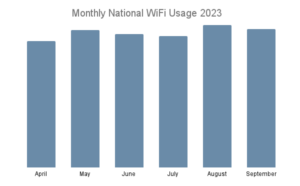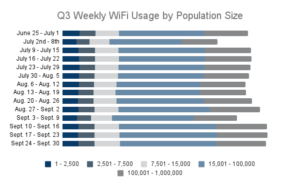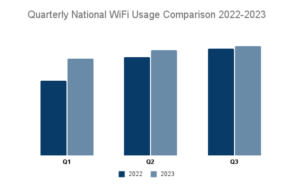3 Innovative Library Summer Reading Ideas
Summer reading programs have long been a staple of libraries, offering a fun and educational way for patrons of all ages to stay engaged during the summer months. This year, we found 3 summer reading ideas from libraries that we had to share. Hopefully they can help to attract more participants and make these programs even more exciting this season.
Fresh Approaches to Summer Reading
Libraries are adopting new methods to make summer reading programs more appealing and accessible. Instead of traditional reading challenges, many libraries are allowing participants to set their own reading goals and are including a variety of activities beyond just reading. This flexibility helps cater to diverse interests and schedules, and makes it easier for more community members to join in.
Balancing Community and Staff Needs
A successful summer reading program balances the needs of the community with the capacity of library staff. By leveraging tools like community calendars and meeting room management systems, libraries can streamline planning and execution. This helps to ensure programs are sustainable and impactful without overburdening staff.
3 Innovative Summer Reading Ideas
Libraries are incorporating a wide range of activities to attract and engage participants. Many of these ideas come from librarians sharing their experiences and suggestions on r/Libraries and r/Librarians on Reddit:
1. One-Hour Events: Short, engaging activities can draw in attendees who might not have time for longer commitments. Some popular ideas include:
- Geocaching: A modern-day treasure hunt that encourages participants to explore their local area and discover hidden caches.
- Campfire Story Times: Evening events where participants gather around a (real or artificial) campfire to share and listen to stories, fostering a sense of community and adventure.
- Book-Themed Crafts: Creative sessions where participants can make crafts related to their favorite books, combining art with literature.
2. Targeted Programs: Tailoring programs for different age groups ensures that there is something for everyone, not just children. Examples include:
- Teen Book Clubs: Offering a space for teenagers to discuss their favorite books and explore new genres together.
- Adult Reading Challenges: Programs specifically designed for adult readers, such as themed reading lists and social gatherings to discuss books over coffee.
3. Community Partnerships: Collaborating with local organizations can provide additional resources and help reach a broader audience, offering more varied experiences. Some successful partnerships include:
- Local Parks and Recreation Departments: Partnering to offer outdoor reading events and nature walks that combine physical activity with literary exploration.
- Schools and Educational Institutions: Working together to promote summer reading and provide educational workshops and activities.
Evaluating and Improving Programs
To continually improve summer reading programs, libraries are setting specific, measurable goals and collecting data on participation and feedback. This allows them to refine their offerings and demonstrate the impact on participants' reading habits and skills.
Enhancing Engagement with Technology
Modern tools are playing a crucial role in enhancing the effectiveness of summer reading programs:
- Community Calendar: A community calendar helps libraries manage and promote events efficiently, gather registrations, and report on their success. This ensures that patrons are well-informed about upcoming activities and can easily participate as well as making it easy to share results with board members and the state.
- Meeting Room Management: Efficient meeting room management ensures that spaces are utilized optimally and avoids scheduling conflicts. Many libraries are supporting a variety of programs and workshops that complement the reading challenges, so avoiding double bookings is especially important during this busy season.
Libraries are successfully revitalizing their summer reading programs by adopting flexible, inclusive approaches and leveraging modern tools to enhance engagement and efficiency. These efforts not only make summer reading more accessible and enjoyable but also strengthen the library's role as a vibrant community hub.
By continuously innovating and improving, libraries can ensure that their summer reading programs remain a beloved tradition. A tradition that brings communities together, and fosters a love of reading in patrons of all ages. If you would like to connect to review how WhoFi's all-in-one suite of services could help simplify library management across the board, we would like to meet. Visit WhoFi.com/demo or email us directly at marketing@whofi.com to schedule a meeting.
https://youtu.be/wGVz-UYAu48
New Library Staff Training Strategies
It can be daunting for new library staff members facing the challenge of learning their roles while understanding the intricacies of library operations. Library staff training often presents obstacles, including communication gaps, time constraints, and documentation issues. That said, a great team with a quality onboarding process can reduce burdens and make taking on a new role less intimidating.
Clear communication, record-keeping, and continuous support are essential elements of successful onboarding. However, libraries sometimes struggle with these aspects due to limited resources and staff time. In this post we’ll explore the challenges associated with onboarding new library staff, share insights from research and interviews with librarians, and discuss how libraries can relieve some burdens utilizing easy to use reporting services such as WhoFi.
Challenges in Onboarding Library Staff
Onboarding new staff members in a library setting presents a unique set of challenges that can impact the efficiency and effectiveness of library operations.
- Communication Gaps
One of the primary challenges in onboarding new library staff is the presence of communication gaps especially when previous staff is not available for training. Libraries may struggle to effectively convey essential information to new hires, leading to confusion and inefficiency. This can be especially problematic in libraries with a smaller staff or high staff turnover rates.
- Time Constraints
Time constraints pose another significant challenge in the onboarding process. Libraries often operate with limited resources and personnel, making it difficult to dedicate sufficient time and attention to properly onboard new staff members. This can result in rushed or incomplete onboarding experiences, hindering the success of new hires into the library team.
- Lack of Documentation
A lack of comprehensive documentation is another common challenge faced during the onboarding process. Libraries may not have had time to create a process to provide new staff members with access to essential resources, policies, and procedures, leading to incomplete understanding. Without proper documentation, new hires may find it challenging to navigate their roles effectively and start serving the community seamlessly.
Importance of Effective Onboarding Processes
Effective onboarding processes play a crucial role in ensuring the long-term success of new librarians and the overall efficiency of library operations. By prioritizing clear communication, documentation, and continuous support, libraries can create a positive onboarding experience that sets new staff members up for success.
- Setting New Hires Up for Success
Clear communication and documentation are essential for setting new hires up for success in their roles. By providing comprehensive information about library policies, procedures, and expectations, libraries can empower new staff members to navigate their roles effectively from day one. This not only boosts their confidence but also enhances their ability to contribute to the library's goals and objectives.
- Fostering a Sense of Belonging
Effective onboarding processes also play a crucial role in fostering a sense of belonging among new staff members. By providing continuous support and guidance, libraries can help new hires integrate into the library team seamlessly. Regular check-ins and opportunities for feedback create a supportive environment where new staff members feel valued and appreciated, enhancing their overall job satisfaction and retention.
- Enhancing Library Operations
In addition to supporting new staff members, effective onboarding processes also contribute to the overall efficiency of library operations. By ensuring that new hires are well-equipped with the necessary knowledge and resources, libraries can minimize disruptions and maintain continuity in service delivery. This ultimately enhances the library's ability to meet the needs of its patrons and achieve its organizational objectives.
To further understand the challenges associated with library staff training and the importance of effective onboarding processes, we explored insights from research articles and interviews conducted with library professionals.
Research Insights
A study conducted by the City University of New York (CUNY) sheds light on the challenges faced by new librarians during the onboarding process. The study emphasizes the importance of clear communication, documentation of institutional knowledge, and regular check-ins for new librarians to succeed in their roles. It highlights the need for library leadership to prioritize effective onboarding processes to ensure the long-term success of librarians. https://academicworks.cuny.edu/cgi/viewcontent.cgi?article=1638&context=qc_pubs
How it helped Huron
In an interview with Chris Mills, branch manager for the North Fairfield and Greenwich locations of Huron County Community Library in Ohio, we gain firsthand insights into the challenges of helping library staff adopt new solutions and the impact of easy to use programs for her library. Chris shared how communication gaps, time constraints, and adapting new technologies have historically hindered processes at the libraries she serves. However, with the implementation of WhoFi, they have streamlined tasks such as planning programs, gathering registration as well as attendance. This has made it easier for new and existing staff across the district to provide Chris the numbers she needs for the state survey.
From both research insights and interview perspectives, it's clear that effective onboarding processes and easy to use technology are crucial for the success of new librarians and the overall efficiency of library operations.
Simplifying Onboarding for Libraries with WhoFi
WhoFi can serve as a valuable ally for libraries seeking to streamline their onboarding processes and enhance efficiency. With its suite of services tailored specifically for libraries, WhoFi offers user-friendly tools for managing programs, reserving spaces, and more.
By simplifying these tasks and providing libraries with easy access to data and reporting tools, WhoFi empowers libraries to overcome lengthy training challenges with an easy to use service covering various library services. By spending time to create effective onboarding processes and leveraging solutions like WhoFi, libraries can ensure the long-term success of their staff and the overall efficiency of library operations.
Are you ready to streamline your library's onboarding processes and enhance efficiency for both current and new staff members? Reach out to us at marketing@whofi.com to book a meeting and explore how WhoFi can simplify tasks such as attendance tracking, program calendar management, and usage statistics reporting.
https://youtu.be/2CPZujv1ulU
Stable Public Library WiFi Utilization Trends in Q1 2024
The latest analysis of public library WiFi utilization in the first quarter of 2024 indicates a stable trend. This stability not only reflects the return of normalcy following pandemic conditions, but also the pivotal role libraries play for patrons. This quarter we will review observed trends, their potential implications, as well as upcoming digital equity grant opportunities from the NTIA.
Monthly Library WiFi Usage - April to March
Examining the data from April 2023 to March 2024 reveals a pattern of stability in usage on the monthly level. This sustained increase suggests a growing reliance on libraries for digital access. This underscores the critical role that libraries play in meeting the evolving needs of their patrons.
Furthermore, the impact of late 2023 usage trends appears to have been mitigated by milder weather conditions nationwide in December. This resilient usage of library WiFi services highlights their commitment to ensuring uninterrupted access to digital resources for patrons.
Comparing Results from Previous Years
A comparative analysis of WiFi usage trends reveals an intriguing shift in the first quarter of 2024. While previous years experienced exponential growth in usage following the pandemic, 2024 appears more stabilized. Going forward libraries will have a leading role in driving future growth. The sustained growth in WiFi usage reaffirms libraries' commitment to bridging the digital divide and underscores their significance as essential community resources.
Libraries continue to play a vital role in providing equitable access to digital resources. In fact, many have sought to partner with state broadband offices to take part in the digital equity act advancing digital equity across the country.
Opportunities for Libraries to Advance Digital Equity
In light of ongoing programs from the Digital Equity Act such as the current Digital Equity Capacity Grant Program, libraries have unique opportunities to contribute to the advancement of digital equity in the form of raising awareness in communities. The NTIA lists digital literacy training, cybersecurity training, and raising awareness of the availability and affordability of access to broadband technology as qualifying activities for this grant. Applications for grant funding are due by May 28, 2024. This grant could provide libraries with resources to enhance their current program offerings. For those interested in more information and how to get involved with their state’s digital equity plan, broadband offices for each state can be found at broadbandusa.ntis.doc.gov/resources/states.
Public Libraries serve as vital community anchors in bridging the digital divide. By leveraging available resources and partnerships, libraries can continue to empower individuals with access to essential digital services, ultimately fostering more inclusive and resilient communities.
Weekly WiFi Usage in Q1 2024
In looking at WiFi usage data weekly, obvious patterns such as lower usage on holidays become clear. The two holidays where decreases in usage occurred this quarter were New Years Day and Presidents Day.
By providing reliable WiFi access, libraries become essential for individuals who rely on digital resources for education, work, and communication. This sustained growth in WiFi usage underscores the enduring impact of libraries in providing equitable access to information and technology.
What Does the Future Hold for Public Library WiFi?
Looking ahead, public library WiFi will continue to be a critical component of library services for the community. Ongoing federal funding initiatives and collaborative continue efforts to expand broadband infrastructure. Going forward, libraries are poised to meet the evolving digital training needs of patrons and advance advocacy efforts.
As technology advances, libraries will remain steadfast in their commitment to providing access to digital resources and fostering digital literacy. By embracing innovation and collaboration, libraries will continue to serve as invaluable resources for their patrons.
To learn more about how WhoFi helps states and individual libraries spend less time gathering data and allows for more time to use it visit us at whofi.com/demo.
https://youtu.be/DAljvQS0NpM
5 Summer Reading Ideas for a Successful Season
Are you looking to create more successful and engaging summer programs for your patrons? It can be a challenge to keep returning patrons informed and attract new community members. And let's not forget managing resources and costs for big events. But don't worry, we're here to help! We've gathered proven summer reading ideas from libraries across the country to help make your summer programs a hit.
1. Get to Know Your Community's Interests: New Rochelle Public Library
Want to create a summer program that excites and brings your community together? Take a cue from the New Rochelle Public Library, who hosted a Summer Reading Kickoff Party that drew over 500 enthusiastic attendees. How did they do it? By asking their patrons what they wanted and delivering a program tailored to their interests. From fun photo ops with beloved book characters to engaging craft activities, they created an event that set the stage for a summer of reading excitement. Read more.
2. Amp Up Your Marketing Game: Pioneer Library System
When it comes to marketing your summer programs, consistent engagement with patrons is pivotal to program success. Take a page from Pioneer Library System's award-winning Summer Learning Challenge in 2022, which saw a 48% increase in registrations and a whopping 65% increase in completions from 2021 to 2022. How did they do it? By leveraging targeted marketing efforts and engaging their community every step of the way. From eye-catching social media posts to personalized email reminders, they spread the word and got people excited about learning. Read more.
3. Collaborate with Local Businesses: Carnegie Library of Pittsburgh
Collaboration is key when it comes to planning big summer events. Just look at the Carnegie Library of Pittsburgh’s post-summer reading celebration, where they teamed up with a variety of local businesses and organizations to host a family-friendly outdoor festival. From musical performances and craft activities to food trucks and storytelling sessions, they created an event that brought the community together in celebration of literacy and learning. By working together with their local business partners, they were able to create an unforgettable experience for attendees while maximizing resources and reaching a broader audience. Read more.
4. Embrace Technology: Hillsborough County Library
In Hillsborough County, libraries are using technology to promote summer reading among children and teens through the Beanstack app. More than 3,600 participants, including 11-year-old Joanna Binu, logged hundreds of hours of summer reading using the app last year. Beanstack allows users to track their reading hours, earn digital badges, and receive book recommendations based on their interests. By leveraging technology, libraries like Hillsborough County are making reading fun and accessible, even for the digital age. Read more.
5. Foster Community Engagement: Free Library of Philadelphia
The Free Library of Philadelphia is teaming up with other anchor institutions across the city to ensure that children and teens have the most fun possible this summer. Through initiatives like "It's A Summer Thing!", families can access a wide range of free or low-cost programs, including summer camps, swimming lessons, reading activities, and more. By collaborating with partners like Philadelphia Parks and Recreation and the Department of Human Services, the Free Library is creating a summer to remember for young people across the city. Read more.
We hope these summer reading ideas will benefit your library as you plan your summer programs for 2024. If you're looking for ways to spend more time planning and less time tracking attendance, WhoFi may be able to help. Click the demo button below to set a meeting and learn more about how we can simplify hosting summer events or email us at marketing@whofi.com. Happy Programming!
https://youtu.be/NQpeR7jROCA
Analysis of Public Library WiFi Usage in 2023
Public Library Insights for 2023
In 2023, public libraries continued to play a pivotal role in fostering digital equity and community engagement. Through collaborative efforts with programs like E-Rate and BEAD (Broadband Equity, Access, and Deployment), libraries served as essential hubs for connectivity empowering individuals with digital literacy training and expanding access to digital resources nationwide. Innovative library promotion strategies like leveraging social media and adding library calendars to websites, enabled libraries to enhance visibility and engage with patrons beyond physical boundaries of the library walls. Join us below as we review library insights from 2023.
In 2023 we witnessed a notable increase in library WiFi usage, driven by several potential factors. This year was the first year that no major cities were required to engage in lockdowns due to the COVID-19 pandemic. Libraries partnered with states to provide information about how to get connected to various programs making internet access affordable. Additionally, public libraries continued to provide essential digital literacy training with plans to expand during BEAD program implementation in many states. Innovative library promotion efforts, heightened library visibility and attracted patrons, contributing to the surge in patronage throughout the year. This expansion of digital infrastructure likely helped to improve usage. This will continue to make libraries central hubs for connectivity within communities.
Why seasonal changes looked different in Q4 2023
Seasonal changes in Q4 2023 looked different than Q4 2022, showcasing a smaller decline in usage during the traditionally low traffic period in December. It is possible that milder temperatures across the country in December 2023 played a role in reducing the seasonal decline. Casual library users in 2022 may have been more likely to wait for milder weather to visit the library. Sustained use of WiFi services throughout the year reinforces the importance of libraries in their communities even through holiday months.
Innovative Library Promotion
Libraries embraced innovative promotion strategies in 2023, leveraging services like TikTok and library calendar software to engage with patrons. This innovative approach resulted in increased visibility, with libraries gaining significant following and fostering digital engagement beyond physical spaces.
Library promotion is a wonderful tool to help librarians ensure they broadcast their offerings to the largest possible audience. By tapping into new avenues of communication and connection, libraries demonstrate adaptability and relevance for patrons of all ages. This further strengthens their role as essential sources of information and digital access.
Interpreting insights for 2024
The insights gleaned from library WiFi usage trends in 2023 provide valuable guidance for anticipating future developments. By staying responsive, keeping up with evolving community needs and leveraging innovative approaches, libraries are poised to continue their service as vital hubs of learning, connectivity, and community empowerment in 2024 and beyond.
The data is clear - libraries are essential players when it comes to providing internet access to under-served communities. According to the American Library Association (ALA), providing access to internet is particularly critical in areas that would otherwise have none.
Reviewing patrons' utilization of library services empowers staff to make data-driven decisions in community engagement. Insights from WiFi analytics remain useful for libraries as they strategize and advocate for future endeavors. If you would like to review how our solutions make gathering these insights easy please click the demo button in the top right of the page.
How to Promote Library Services: Insights from California, Washington, and Utah
Recently it was brought to our attention that libraries in Washington, California, and Utah are successful in promoting their services. In this article, we explore the success stories of these libraries, revealing strategies and best practices for how to promote library services. Discover these resources to transform your library's promotional efforts.
Engaging the Community: Strategies that Work
Building a strong community connection is vital for successful library promotion. We hope you find something beneficial from Washington, California, and Utah as we explore their proven strategies:
Events and Workshops: Successful libraries host diverse events aligning with community interests, such as book clubs, story times, and coding workshops. Salt Lake City Public Library even offers an Introduction to Sewing program for all ages! These create inclusive spaces, encouraging active community participation.
Partnerships with Local Organizations: Collaborating with library supporting community members expands networks and leads to idea sharing. For example, Seattle Public Library partners with local businesses to help small businesses and entrepreneurs grow. This increases library visibility and provides a unique community experience.
Advocacy for the Community: Many libraries go above and beyond to secure grants to host new programs or make improvements to services or facilities. Just this month Santa Barbara Public Library secured a grant to host a series of programs surrounding sustainability and promote local resources to get involved.
- Salt Lake City Public Library - https://events.slcpl.org/events?r=thismonth
- Seattle Public Library - https://www.spl.org/programs-and-services/business-and-nonprofit
- Santa Barbara Public Library - https://www.independent.com/2024/01/04/santa-barbara-public-library-awarded-grant-for-sustainability-initiatives/
Harnessing the Power of Social Media
Libraries recognize the influential role of social media in promoting services. Platforms like Facebook, TikTok, and Instagram provide dynamic tools for engagement:
Active Social Media Presence: Maintaining an active presence allows libraries to share engaging content, fostering a sense of excitement and anticipation. Recently Solano County Library has made big waves under supervisor Mychal Threets gaining 25,000 followers for the library and spreading “library joy”.
Community Building: Social media platforms facilitate real-time discussions, feedback, and personalized interactions, building strong relationships with patrons. Many libraries even share upcoming events to their Facebook followers and offer online registration for programs.
By harnessing social media's power, libraries seamlessly connect with audiences, creating a foundation for increased community support.
- Solano County Public Library Story - https://www.marinij.com/2024/01/08/mychal-threets-works-to-spread-library-joy/
- Solano County Public Library TikTok - https://www.tiktok.com/@solanolibrary
Collaboration: Library Resources
Libraries can amplify their impact by collaborating with state library resources. There is no need to reinvent the wheel with many state libraries offering guidance and best practices for keeping things running smoothly.
Resource Sharing: State libraries from Washington and California provide a number of articles and resources for seasonal and year round programs alike. These are great resources to spark program planning creativity.
Training and Development Programs: Librarians benefit from collaborative programs, gaining fresh insights and innovative ideas for promoting services. Library Facebook Groups like Library Management Group or Library Think Tank.
State Library Associations: Networking opportunities through conferences and workshops connect librarians across the state, fostering collaboration and support. This is a great way to meet librarians that share unique challenges and solutions in your own state.
Access to Funding Opportunities: Collaboration with state library agencies opens doors to funding programs, supporting initiatives to effectively promote services. There are a number of funding opportunities listed by most state libraries.
- You can find a full list of state libraries here - https://www.lib-web.org/united-states/state-libraries/
- California State Library Program Ideas - https://www.library.ca.gov/services/to-libraries/ideas/
- Washington State Library Summer Reading - https://www2.sos.wa.gov/library/libraries/projects/summerreading/
Success Story Insights
The success stories from Washington, California, and Utah offer valuable insights into effective library promotion. By engaging the community, embracing innovative outreach, harnessing social media, and collaborating with state library resources, libraries can create thriving environments for all ages and backgrounds. As you continue to promote your own library services, we hope you can draw inspiration from these stories to make a powerful impact in your community.
If you’re looking for technology solutions to help you with the promotion and advocacy of your library, WhoFi is helping libraries across the country. WhoFi offers cutting-edge tools and solutions to analyze your library's data, understand your patrons' needs better, and tailor your promotional efforts for maximum impact. WhoFi empowers you with actionable insights to drive meaningful connections with your community. To learn more, schedule a demo by clicking the button below.
https://youtu.be/icOza4XmtjM
Library Membership Management Solutions
In the digital age fragmented and complex systems are becoming a thing of the past. In this post we will discuss library membership management challenges and present an all-in-one suite of services as a potential solution. To satisfy the goals of public library directors, we've collected insights about related challenges in conversations with partners.
Common Library Challenges:
Shared Control of Spaces: Libraries try to ensure patrons have ready access to resources without conflicts. However, promoting services to the community and managing shared spaces efficiently is often difficult.
Program Registrations: Gaining registrations for library programs is critical, yet takes time when completed on paper or over the phone. To maintain community engagement, it is essential to provide an easy and seamless process to keep programs in full attendance.
Avoiding Double Bookings: Libraries, serve as maker spaces, study areas, and program hosts, often at the same time to meet patrons' varied needs. Finding the right balance can be a challenge, and double bookings can lead to frustrations.
Library Membership Management Solutions:
Community Calendar: WhoFi's Community Calendar simplifies event scheduling and provides a central hub for library programs right on the library website, to enhance community engagement. Additionally, collecting registrations early online allows program planners to prepare proper spaces and supplies.
Spaces: WhoFi's Meeting Room management feature allows patrons to book spaces quickly and use resources efficiently. Synchronizing with the library calendar helps avoid conflicts and maximize library space utilization. Directors can approve patron reservations and send confirmation and reminder emails directly from the dashboard.
WiFi Analytics: WhoFi's WiFi Analytics provides comprehensive data about foot traffic and library WiFi usage over time making answering these questions on the state survey easy.
With WhoFi's all-in-one suite of services, directors can access efficient solutions to their library membership management challenges. Transform the future of library management with WhoFi and explore a world of possibilities for your library community. You can visit our YouTube for videos about these services, and click the button below to schedule a meeting.
https://youtu.be/jzsn05UJ5z0
2024 Library Resolutions and Library Software Solutions
As we approach 2024, libraries are gearing up for a transformative year focused on advocacy and efficiency. The New Year brings with it the perennial challenge of reporting, requiring meticulous data collection on WiFi usage, program attendance, space utilization, and more. These challenges can create bottlenecks, hindering librarians from crafting positive experiences for patrons. To overcome these hurdles, libraries are exploring comprehensive library software solutions dedicated to meeting and exceeding expectations for improved efficiency and productivity.
Library Software Solutions
Library software services stand out as a potential remedy, offering tools like a library calendar and wireless sessions software. These solutions are designed to confront survey challenges head-on, allowing librarians to redirect their focus back to the community. By automating data compilation and providing comprehensive training resources, these solutions simplify reporting tasks.This ensures that the onboarding process for new staff is seamless, maintaining the uninterrupted flow of library operations.
Leveraging Library Software for Resolutions
- Spend More Time with Patrons: By leveraging library software, librarians can allocate more time to creating positive library experiences for patrons.
- Reduce Survey Challenges: Library software solutions address survey challenges directly, streamlining reporting tasks and freeing up valuable time.
- Increase Strategic Activities: Automated data compilation from library software empowers librarians to engage in strategic activities, make data-driven decisions, and plan for a thriving future.
- Simplify Staff Onboarding: Library software ensures the onboarding process remains seamless, even in times of high staff turnover.
By embracing library software solutions, librarians can confidently pursue their New Year's goals. This not only saves time and resources but also empowers libraries to make data-driven decisions for the future. As we enter into a new year, let's embrace the future, secure in the knowledge that a successful year ahead is well within reach.
Additional Resources
- WhoFi Library Software - Discover the suite of library software services.
- WhoFi Software Reviews - Hear what other libraries have to say.
- WhoFi YouTube Channel - Check out our "Start Here" playlist to learn more!
Please reach out to WhoFi at marketing@whofi.com or click the button below if you would like to learn more. We are happy to set a meeting to discuss how we can help with your library resolutions checklist.
5 Wonderful Library Winter Program Ideas
As we head into the Winter season, public libraries across the country are preparing to offer heartwarming programs for all of their patrons. These library Winter program ideas are inspired by the creativity of other libraries, showcasing the positive impact that bringing communities together through programs can have. Looking for another program to add to your library's Winter lineup? Take inspiration from what other libraries are doing below!
Five Library Winter Program Ideas
- Winter Reading Challenge
- Keep the pages turning during winter break by launching an exciting Winter Reading Challenge for children. Sharing this program on Facebook and the library website is a great way to increase participation.
- Gingerbread House Making Program
- Gather families together for a delightful and delicious gingerbread house-making event. Watch creativity unfold and Experience the joy of the season together. Make sure to prepare enough supplies for this culinary craft by collecting registrations online.
- Gather families together for a delightful and delicious gingerbread house-making event. Watch creativity unfold and Experience the joy of the season together. Make sure to prepare enough supplies for this culinary craft by collecting registrations online.
- Drive-Thru Canned Food Drive
- Turn kindness into a winter tradition with a drive-thru canned food drive. Make it easy for your community to give
back and make a meaningful impact. Promoting drop off location on the library calendar makes it simple for donors to make their donations.
- Turn kindness into a winter tradition with a drive-thru canned food drive. Make it easy for your community to give
- Snowga Series for Adults
- Cultivate serenity and mindfulness with a meditative yoga series for the Winter months. It's a wonderful opportunity to bring a sense of warmth and tranquility to adult patrons during the winter season.
- Make Your Own Greeting Cards
- Invite patrons to unleash their creativity by crafting personalized greeting cards. Whether it’s for the holidays or just to brighten someone’s day, this hands-on activity promises joy and connection.
Simplified Program Planning, Promotion & Reporting
Effortless registration becomes a reality with effective library calendar software, allowing patrons to sign up for any exciting library Winter program with just a few clicks. Embedding program details on your library website can be simple with integration options for the library website keeping the community informed. Plus, social media sharing becomes a breeze if each event has its own unique web page. WhoFi offers Community Calendar as an all-in-one solution for programming needs at the library and amplifies the library’s event offerings all year.
Please reach out to WhoFi at marketing@whofi.com or click the button below if you would like to learn more and set a meeting to discuss simplifying the process of planning programs for the library you serve.
https://youtu.be/-3cHe2FF_fE
Public Library WiFi Sessions Q3 2023
Third Quarter 2023: Public Library WiFi Sessions and Digital Equity Trends
https://youtu.be/g6xQ8WU06Gw
The third quarter of 2023 reaffirmed the critical role public libraries play in providing equitable internet access within the communities they serve. Against the backdrop of increased Summer travel, libraries experienced noteworthy stability in library WiFi sessions. Despite increased travel among patrons, sustained usage patterns revealed the enduring importance of the essential services libraries provide, catering to the needs of the community.
Third Quarter 2023 Monthly WiFi Usage Trends
A month over month view of Library WiFi usage through the summer shows high usage through all of the summer months with May and August having the highest visitor counts. While the third quarter showed fluctuations in monthly and weekly patterns, as a whole, it showed continued growth, surpassing the previous year's figures. This achievement is particularly commendable as it aligns with the end of Summer Reading programs and sets the stage for a promising Fall season. Congratulations to libraries for their dedication to fostering community engagement and digital access as we transition into this new chapter.
Throughout the third quarter of 2023, libraries experienced consistent growth in monthly WiFi sessions, surpassing the usage recorded in 2022. From May into July, there was a gradual decline in WiFi usage, reflecting the typical decrease in demand during the early summer months. However, as the summer progressed, there was a notable resurgence in August, indicating increased community engagement and demand for digital resources.
This uptick was a testament to the success of summer programs and the libraries' ability to captivate patrons. However, with the return to school activities in September, there was a minor decrease in usage, aligning with the usual adjustments in community needs.
Summer Holiday Travel Trends
As anticipated, the third quarter saw a decline in WiFi sessions during the week of the Fourth of July and Labor Day, in line with the typical dip observed during traditional holiday periods. These brief intervals of reduced activity were counterbalanced by sustained engagement during the remaining weeks, emphasizing the libraries' remarkable resilience and adaptability. Libraries effectively met community demands, navigating fluctuating usage patterns and ensuring consistent support for patrons, despite expected lulls.
When analyzing quarterly usage between 2022 and 2023, a discernible positive trend emerged. Despite minor fluctuations, the overall usage for the quarter exceeded that of the previous year, highlighting the enduring significance of public libraries as vital hubs for digital resources and connectivity. This sustained growth reaffirms libraries' pivotal role in fostering digital equity, bridging the digital divide, and ensuring equitable access to information and technology for all members of the community.
Positive Outlook and Community Impact
As libraries forge partnerships with states to leverage BEAD funding for broadband deployment, they stand at the forefront, ready to expand connectivity and act as central information hubs for those lacking adequate access. Through a harmonious blend of engaging programs and WiFi availability, libraries have solidified their status as indispensable community resources, ensuring equal access to digital resources.
Moving forward, the numbers are clear that public libraries remain steadfast in their mission to provide equitable access to digital resources. The positive trends observed in the third quarter of 2023 reaffirm the crucial role of libraries in our communities. With the support of initiatives like the BEAD Program and the dedication of library professionals, the future holds even greater promise for enhancing digital equity and ensuring universal access to information.
What Does the Future Hold for Public Library WiFi?
The incremental growth witnessed during the third quarter of 2023 stands as a testament to the enduring dedication of libraries to address the evolving needs of their communities. Libraries persist in their pivotal role as champions of digital equity, actively bridging the digital divide, and acting as essential information access points for patrons from diverse backgrounds. This steadfast commitment underscores libraries' resolve to create an inclusive and digitally empowered society, ensuring equitable opportunities for all.
If you would like to learn more about WhoFi and how we can simplify gathering wireless sessions, program attendance, and more, please visit whofi.com/libraries or contact us at whofi.com/demo.







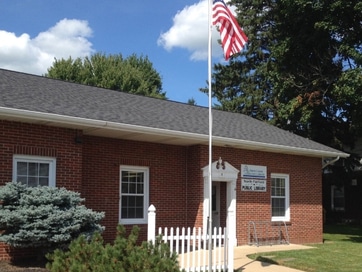


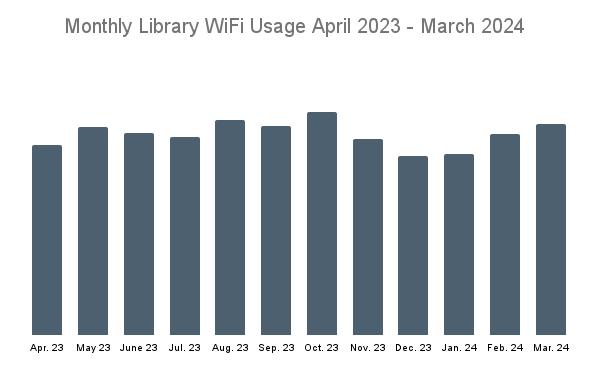
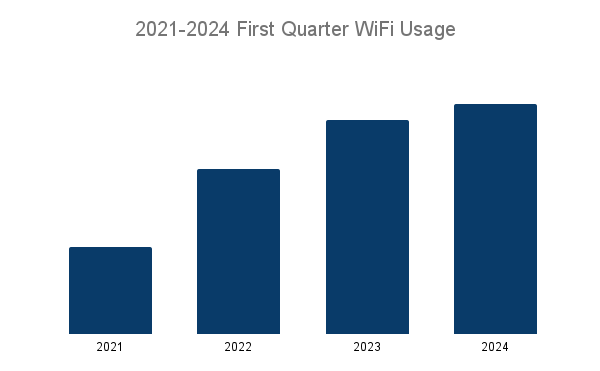

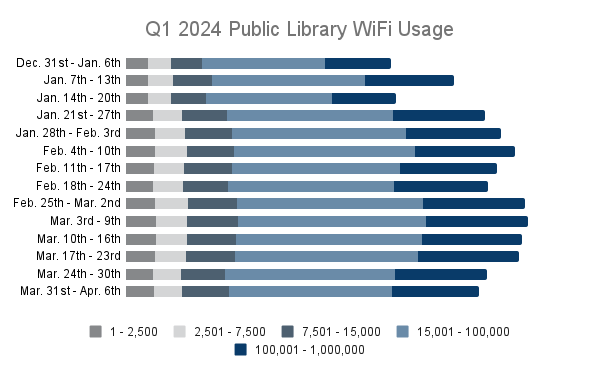





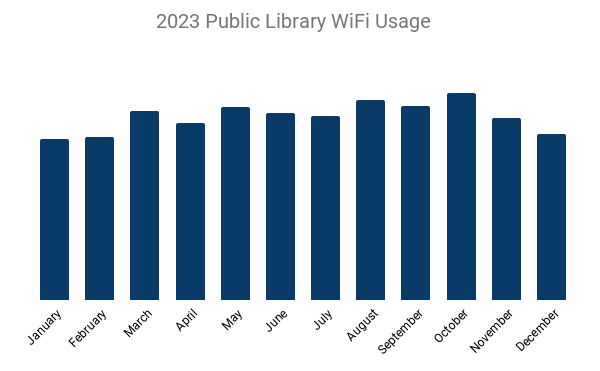
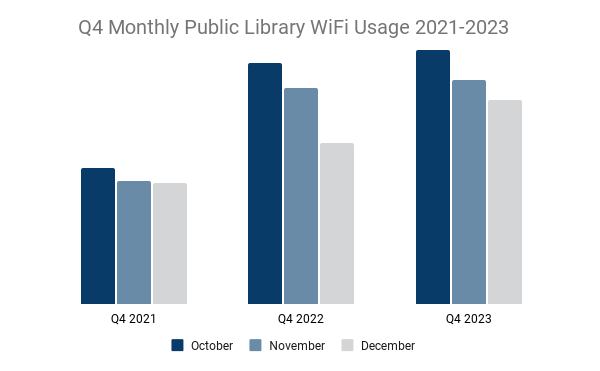
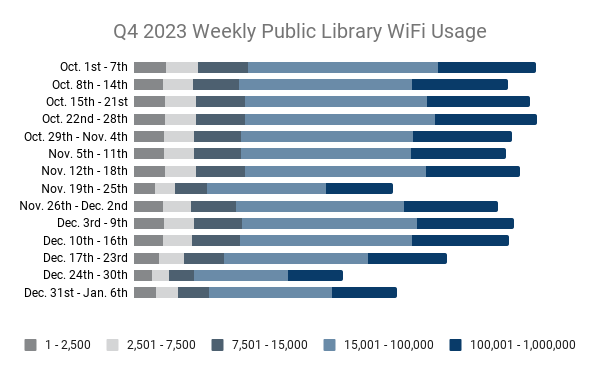


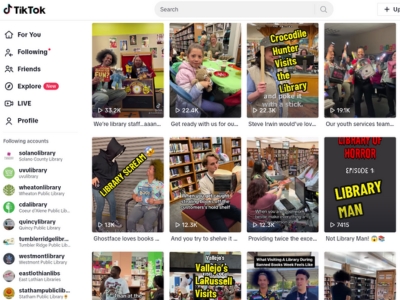





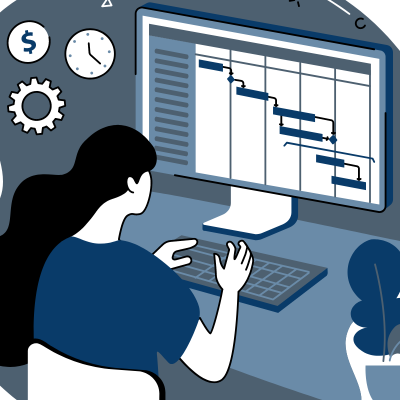
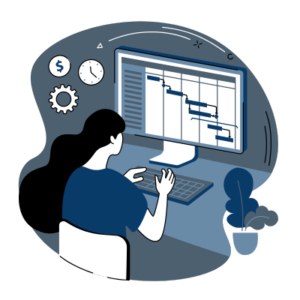
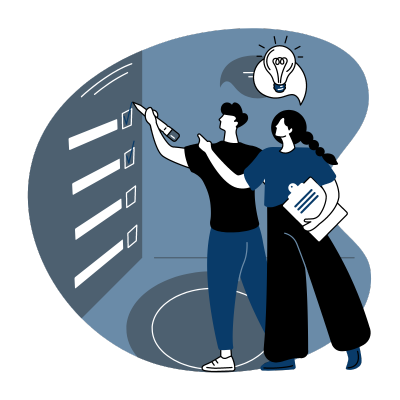



 back and make a meaningful impact. Promoting drop off location on the library calendar makes it simple for donors to make their donations.
back and make a meaningful impact. Promoting drop off location on the library calendar makes it simple for donors to make their donations.

